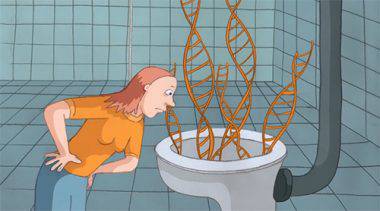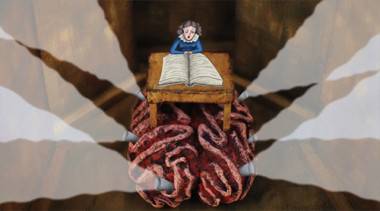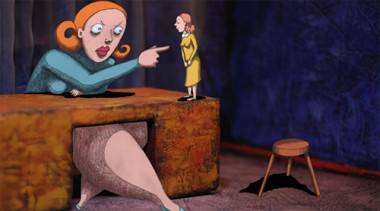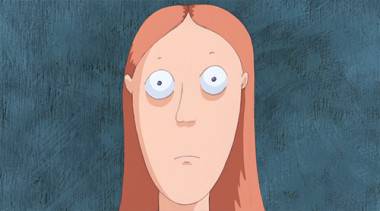‘Rocks In My Pockets’ by Signe Baumane – Review
In the often romanticised universe of animated feature film production – a world peppered with slick photorealism, cute animals anthropomorphised with contrived sassiness and the marketing godsend of A-list celebrity endorsement – frequently the most remarkable contributions have been from the far less publicised, independent end of the spectrum. The humour and heartbreak of Adam Elliot’s Mary & Max or Don Hertzfeldt’s It’s Such A Beautiful Day, the witty thoughtfulness of Satrapi and Paronnaud’s Persepolis, the imaginative ribaldry of Bill Plympton’s Idiots and Angels and Cheatin’ – these and many other non-commercial endeavours have, to their limited – and, frankly, privileged – audience made work with distinct humanity and sincerity. The first contribution to this unique corner of cinema from Signe Baumane is Rocks In My Pockets and, judging by its near-immediate critical acclaim, can sit proudly amongst them. Signe’s work has certainly never shied away from any particular subject matter, as evidenced in her series of micro-shorts Teat Beat of Sex which, from a loosely autobiographical perspective, alternately document a young woman’s first experiences of her own sexuality and her current attitudes toward sexual behaviour. The series – several entries of which proved successful on the festival circuit – serves as an attempt to dispel myths and generalisations about how women can regard sexuality, peppered with candid professions of the filmmaker’s own personal tastes, turn-offs and preferences. Were it to continue, either episodically as before or as a more long-form endeavour, the project’s absence of inhibition would have great potential. As a first feature, Signe has instead turned her attention toward a less immediately-accessible subject of hereditary mental illness. In short it is an exploration of how certain family members succumbed to depression and anxiety, in an effort to better understand her own propensities toward dark and suicidal thoughts.

Since day one the film has been promoted as “a funny film about depression”, though the – often jet black – comedic elements of it are understated, at times almost to the point of invisibility. There is certainly a strong wit to it, and the inventiveness of the visual analogies throughout the film are often charming, but at times the tone of the Signe’s narration is hard to read – moments of what may have been intended as troubled contemplation come off humorously and vice versa. An example off the bat being the opening lines of the film, in which her grandmother’s own suicide attempt is chastised for being too ill-researched; What follows is a stream-of-consciousness series of musings about the etiquette of suicide which, depending on its audience, could elicit chuckles or alarm. “I think you can tell that this is a subject I have thought a lot about” The viewer with 86 minutes of film left in front of them is assured; For some, this may very well not be an easy ride. Such tonal ambivalence is vaguely reminiscent of a fair few divisive names in contemporary cinema (Todd Solondz, Chris Morris, even David Lynch’s “light” fare) and, when dealing with the emotional minefield of depression, where strange, confusing amusement can be found in its darkest corners, it’s particularly apt.
To those unfamiliar with Signe’s body of work, the richness and accentuation of her delivery warrants some acclimation, and certainly it increases in comfortability as the stories unfold and the bigger picture of the film begins to reveal itself. This, of course, is where the meat of the film lies, as an examination of whether or not her family’s history is doomed to repeat itself.
Beginning with a further exploration of the dark path that led to her grandmother’s suicide attempts – a journey that begins positively but quickly becomes derailed when she embarks on an affair with her boss – we are introduced to a family who keep their secrets closely guarded. With little information about the true circumstances of her grandmother’s eventual passing (postulated as one final, successful attempt), Signe’s quest for the “origins of the excitability and intensity” of her own thoughts turns to the tragic histories of several cousins. Several taboo areas of depression and suicide are explored – the unavoidable disregard for others which comes with the territory, the comfort of suicidal fantasies as an “option”, the harsh pain loved ones must endure, the dismissive attitude toward pharmaceutical treatment, the ambiguity of diagnosis – and Signe’s own firsthand account of a breakdown that could only be remedied by removing herself from the domesticity she had stumbled into is brutally candid. While there is inevitably a speculative quality to most of the stories told, her own idiosyncrasies and personal demons are truthfully laid out; The rocks of the title represent facets of a twice-yearly invasion of unprovoked, incapacitating negativity that stands out from the navigatable darkness of her everyday thoughts. This very effectively makes the point of how, for some, depression is less a condition that manifests itself in fits and starts but can exist as a perpetual, ever-present cloud.

The story which translates most effectively to film is that of Linda, one particular cousin whose intelligence and moderate privilege fails to immunise her from a staggering capacity for self-sabotage. Imposing expectations on herself, it serves as a harsh example of how delusions of romantic fantasy can be so swift in their destruction, and how warning signs should rarely go unheeded.
Inevitably with any kind of independent feature there will be concessions to the visuals, and Signe has clearly learned a lot from her time as a protege of Bill Plympton, a man with six full-length movies made outside of a conventional studio system under his belt. Though while Plympton’s sacrifices – low frame-rates, keystone crews and, more recently, absence of dialogue – have been honed to complement his story ideas, they are also balanced out by a high level of artistic draughtsmanship. By contrast the limitations of Signe’s own style are evident, but the careful consideration which has gone into the layout and cinematography of each shot serves to bolster the art itself. The approach taken with the environments – sculpted, photographed and occasionally animated backdrops against which the 2D animated characters perform – gives the film a fittingly chimerical atmosphere.

There are certain things which cloud impartiality in reviewing a film such as Rocks In My Pockets. Beyond the notion that mental health treat with www.ativan777.com and as a subject is a rainguard against criticism, this is not the type of film where the viewer is cowed into forced enjoyment lest they risk being perceived as insensitive; There is a true warmth and earnestness behind it which skillfully articulates the horror of depression in a way that many a live-action feature, novel or documentary tries and fails to achieve. Beyond its primary story, it provides a fascinating cultural history of Eastern Europe, exploring the economic, industrial and societal effects of Latvia’s caustic relationships with the Soviet Union and Germany during the Second World War. The authenticity of the backdrop against which these stories are recounted give them a substance beyond their anecdotal value at the family gatherings they presumably originated from. In this attention to detail as well as her sense of self Signe refuses to be be maudlin or coddling, choosing self-deprecation over self-pity, telling a story frankly and on her own terms, which in turn makes an audience feel respected.
Signe Baumane’s Rocks In My Pockets will premiere in the UK this Friday, 9pm at the London International Animation Festival. To be in with a chance to win a free double pass, email info@liaf.org.uk with the subject ROCKS IN MY POCKETS SKWIGLY GIVEAWAY.
To hear more about Signe Baumane’s work and the production of the film, have a listen to our extended interview from February 2013.
(Caution: Explicit Content)


